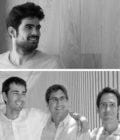







The project’s main objective is to get a successfully integration in its environment, respecting the restrictive urban planning regulations that the island has because of its special architectural and landscape character, classified as a protected heritage area.
The introduction of this hotel could promote a new sensibility towards the delicate urban landscape of this island and motivate a positive impact by changing the existing tourism model for a less crowded situation. We are trying, therefore, to propose a new building typology of temporary housing that Tabarca requires: a kind of larger house opened to the island’s visitor.
By retaining the uninterrupted section of the typical local house, the project achieves a series of continuous spaces through creating intermediate levels and visual connections, resulting in a continuous route leading from the entrance to the roof. The absence of corridors creates relations through wide spaces. The lounge on the ground floor features double volume space, and is connected diagonally with a spacious hallway on the first floor. This central space is naturally illuminated by 2 skylights that channel light indirectly from the roof terraces of the suites.
The big gate on the front facade highlights from the rest of the elements and gives to he building a more public character. This great iron grill acts as the primary threshold between the interior space and the street and creates an outdoor hall, while maintaining natural ventilation.
In addition to the large entrance gate, the front facade maintains a simple composition, with a small window on the ground level and balconies on the first level. Meanwhile, the back elevation comprises of equal vertical openings in both levels, with iron grills as a visual filter and protection on the ground level and balconies on the first level.
As for the hotel layout, the ground floor welcomes visitors with a large space that works as a reception and the double height lounge for common services.
This lounge organizes the general operations of the hotel and well-illuminated and ventilated through the iron gate and the outdoor hall. The north area of the ground floor is dedicated to 3 rooms which can be accessed through a secondary hallway, adjacent to the reception area.
On the first floor, the wide hallway gives access to the remaining 7 rooms. 5 of them are on the same level of access (2 south-facing and 3 north facing) while the 2 suites are accessed through their private stairways that lead to the attic level, similar to the room on the topmost level in a traditional Tabarca house, commonly known as “estància de més amunt”.
This project, finally, reinterprets the use of traditional materials and construction techniques of the island. The building forms a catalogue of this construction systems, reiterating their tested properties in terms of durability, maintenance and functionality.
The point is to rethink the performance of these materials and understanding their use in architecture in a contemporary form.
In this project have been used mainly and largely ceramic materials, due to its diversity in terms of formats, finishes and colors, its ease of execution, its versatility both for outdoor uses on deck (waterproofing) and pavements (friction and wear) and as interiors in floors and walls of bathrooms (watertightness) and for being natural products from the earth, mud and sand, which generate natural, calm and comfortable environments.
So there are 3 important elements in which the ceramic has given the appropriate response to the project’s demands: the roof bricks have been used as structural elements in the floors, as a complement to the visible structure of steel beams and joists; the clay tile has been used as an alternative to the flat tile on the roof, due to its versatility to be used both in vertical and horizontal elements, also appearing in the reception wall and as a flooring in the common space at double height of the ground floor; finally, the traditional tile has served to get an open solution of bathroom in the rooms, both in floors and walls and even forming unique craft ceramic sinks.
Familia Santacruz (Casa IAIA Providencia S.L.)
Diego López Fuster
Subarquitectura (Andrés Silanes, Fernando Valderrama, Carlos Bañón)
Jesús Granada